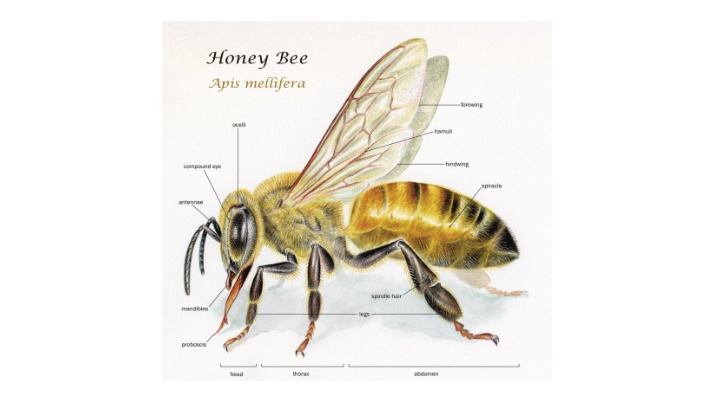



Bombus terrestris
Leioprochotus species, native bee, New Zealand Classification 18 specie cies Kingdom: Animalia Phylum: Arthropoda Class: Insecta Order: Hymenoptera Family: Colletidae Genus: Leioproctus Species: Leioproctus Common name: Hairy colletid bees
FA FACET ETS O S OF H F HONEY EY BE BEE E PO POLLIN INAT ATION ION Insects pollinate most species (87.5%) of the World’s flowering plants, Pollinators consist primarily of 20,000 species of bees (low altitudes and mid latitudes); and secondarily,120,000 species of flies (high altitudes and high latitudes), Apis mellifera and A. cerana, the principal western and eastern honey bees, respectively, are, by far, the most ubiquitous; managed pollinators of 75% of the planet’s flowering food crops, Greater diversity and abundance of honey bees markedly increases crop quality and quantity, particularly in the absence of contaminating acaricides, bactericides, fungicides, miticides, moluscicides and/or pesticides (e.g. chlorothalonil).
FA FACET ETS O S OF H F HONEY EY BE BEE E PO POLLIN INAT ATION ION Global food crop production increased >2-fold from 1961 through 2012; whereas abundance of honey bee populations decreased substantially throughout the same period, Human well-being became increasingly dependent on pollination of agricultural flowering crops – this trend will increase further as food consumption continues toward greater consumption of vegetable products, requiring less costly high-carbon inputs, Pesticide usage World-wide: 200 millions tonnes per annum
Food production losses in the absence of honey bee pollination Without bees, World population could be depleted of food within four years
Chlorothalonil 2,4,5,6-Tetrachlorobenzene-1,3-dicarbonitrile 4-Hydroxy-Chlorothalonil
Methyl-Thiophanate Methyl N-[2-(methoxycarbonylcarbamothioylamino) phenyl[carbamothioyl]carbamate Description: Methyl-Thiophanate is a broad- spectrum pesticide and fungicide toxic to parasitic worms, including nematodes Applications: The pesticide causes liver and thyroid hypertrophy and its ranked carcinogenic for humans. It’s a component of strips for treating parasitic varroa mites in bee hives
Tau-Fluvalinate (RS)- α -cyano-3-phenoxybenzyl N-(2-chloro- α,α,α -trifluoro-p-tolyl)-D-valinate De Descrip ription: tion: A synthetic pyrethroid applied as an insecticide/ acaricide/miticide against aphids, leaf- hoppers, leaf-rollers, moths, thrips and varroa mites Appli lications: ions: Avocados, cereals (including wheat), cherries, nectarines, peaches, plums, potatoes, tamarillos, turf, and bees ( Apis mellifera; A. cerana )
Chlorothalonil’s Action on Cellular Apoptosis - 2015
Chlorothalonil’s Action on Cellular Non-Apoptosis - 2015
Domestic honey bee - Apis mellifera
Landcare Research Ministry for Primary Industries Bee Industry Advisory Council ‘Report on the 2015-New Zealand Colony Loss and Survival Survey’ ‘Report on the 2015-New Zealand Honey Bee Colony Loss and Survival Survey’ COLOSS-NZ survey cites definitions: ‘Colony Collapse Disorder (CCD) and ‘Colony Depopulation Syndrome (CDS) ’ “….the survey is not intended to diagnose CCD or CDS in New Zealand.”
Minis inistry ry of Prim imary ary Indust strie ries: Ho Honey Bee Co Colon lony Loss Surve vey y 2015 Ne New w Zealand Colony lony Survey rvey: : First national survey assessing bee colony losses; involved 316 beekeepers with >401 and 50 beekeepers with <400 hives , Survey y includes: Total of 366 Beekeepers covering 225,660 hives housing 39.6% of bees country-wide, Survey y excludes: Total registered beehives in New Zealand 575,000, number increased by 68,625 hives from 2014, therefore national survey did not include: 349,340 hives, Results: Beekeeper’s with >251 hives: colony loss of 10.73% (± 2%)
REGIONAL LOSS OF HONEY BEE COLONIES * * * * * * * * Auckland Waikato Coromandel, Bay of Plenty Taranaki, Manawatu Northland, Hauraki Plains King Country, Taupō Rotorua, Poverty Bay Hawkes Bay, Wairarapa * * * Marlborough Otago, Southland Canterbury, West Coast Nelson, West Coast * QUEEN PROBLEMS AFB COLONY DEATH * DISASTERS WASPS THEFT
Brachyhesma sulphurella, Australia
Male orchid bee, species unknown, Guyana
Male digger bee, Habropoda excellens , Utah, USA
Recommend
More recommend